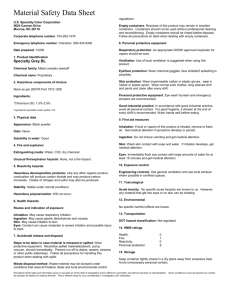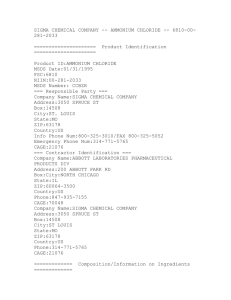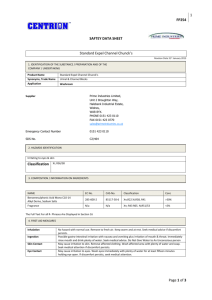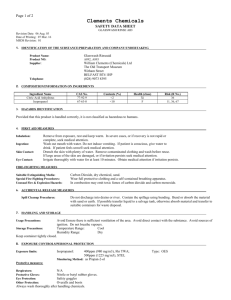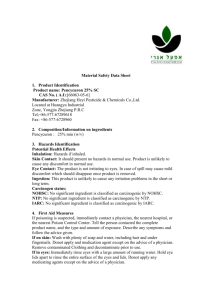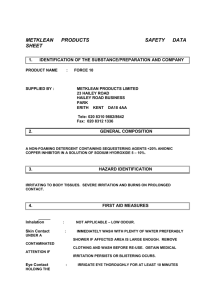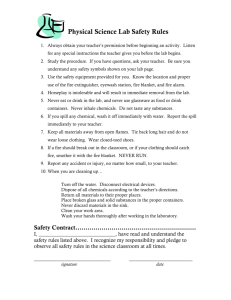View MSDS PDF
advertisement
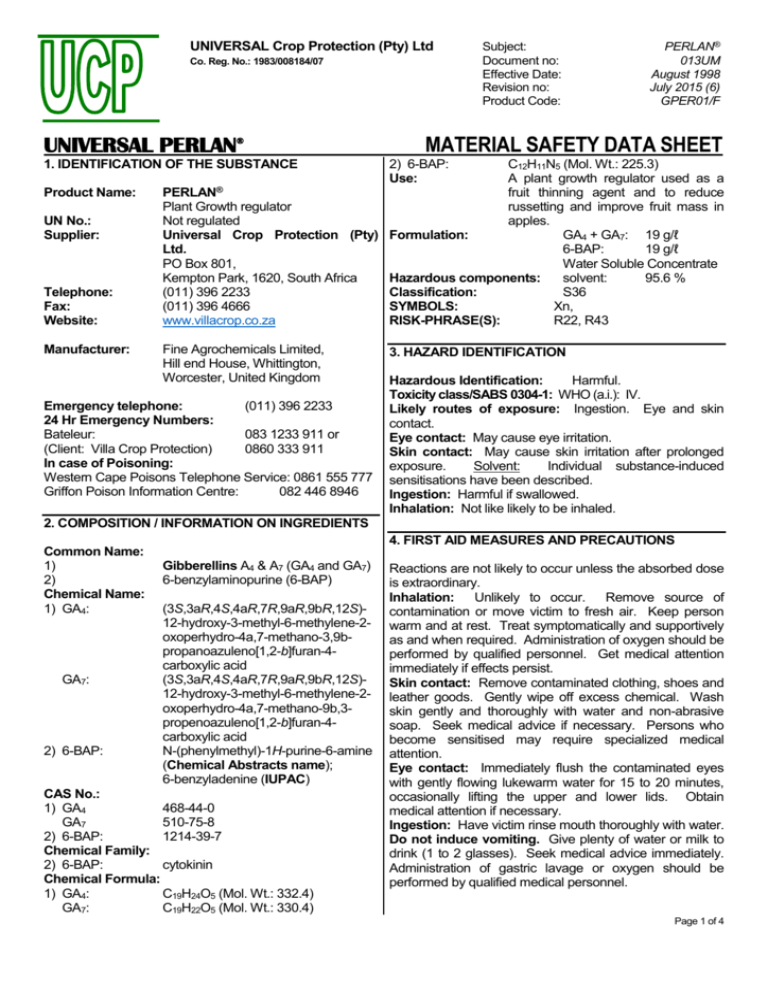
UNIVERSAL Crop Protection (Pty) Ltd Co. Reg. No.: 1983/008184/07 UNIVERSAL PERLAN® 1. IDENTIFICATION OF THE SUBSTANCE Product Name: UN No.: Supplier: Telephone: Fax: Website: Manufacturer: Subject: Document no: Effective Date: Revision no: Product Code: PERLAN® 013UM August 1998 July 2015 (6) GPER01/F MATERIAL SAFETY DATA SHEET C12H11N5 (Mol. Wt.: 225.3) A plant growth regulator used as a PERLAN® fruit thinning agent and to reduce Plant Growth regulator russetting and improve fruit mass in Not regulated apples. Universal Crop Protection (Pty) Formulation: GA4 + GA7: 19 g/ℓ Ltd. 6-BAP: 19 g/ℓ PO Box 801, Water Soluble Concentrate Kempton Park, 1620, South Africa Hazardous components: solvent: 95.6 % (011) 396 2233 Classification: S36 (011) 396 4666 SYMBOLS: Xn, www.villacrop.co.za RISK-PHRASE(S): R22, R43 Fine Agrochemicals Limited, Hill end House, Whittington, Worcester, United Kingdom Emergency telephone: (011) 396 2233 24 Hr Emergency Numbers: Bateleur: 083 1233 911 or (Client: Villa Crop Protection) 0860 333 911 In case of Poisoning: Western Cape Poisons Telephone Service: 0861 555 777 Griffon Poison Information Centre: 082 446 8946 2) 6-BAP: Use: 3. HAZARD IDENTIFICATION Hazardous Identification: Harmful. Toxicity class/SABS 0304-1: WHO (a.i.): IV. Likely routes of exposure: Ingestion. Eye and skin contact. Eye contact: May cause eye irritation. Skin contact: May cause skin irritation after prolonged exposure. Solvent: Individual substance-induced sensitisations have been described. Ingestion: Harmful if swallowed. Inhalation: Not like likely to be inhaled. 2. COMPOSITION / INFORMATION ON INGREDIENTS Common Name: 1) 2) Chemical Name: 1) GA4: GA7: 2) 6-BAP: 4. FIRST AID MEASURES AND PRECAUTIONS Gibberellins A4 & A7 (GA4 and GA7) 6-benzylaminopurine (6-BAP) (3S,3aR,4S,4aR,7R,9aR,9bR,12S)12-hydroxy-3-methyl-6-methylene-2oxoperhydro-4a,7-methano-3,9bpropanoazuleno[1,2-b]furan-4carboxylic acid (3S,3aR,4S,4aR,7R,9aR,9bR,12S)12-hydroxy-3-methyl-6-methylene-2oxoperhydro-4a,7-methano-9b,3propenoazuleno[1,2-b]furan-4carboxylic acid N-(phenylmethyl)-1H-purine-6-amine (Chemical Abstracts name); 6-benzyladenine (IUPAC) CAS No.: 1) GA4 468-44-0 GA7 510-75-8 2) 6-BAP: 1214-39-7 Chemical Family: 2) 6-BAP: cytokinin Chemical Formula: 1) GA4: C19H24O5 (Mol. Wt.: 332.4) GA7: C19H22O5 (Mol. Wt.: 330.4) Reactions are not likely to occur unless the absorbed dose is extraordinary. Inhalation: Unlikely to occur. Remove source of contamination or move victim to fresh air. Keep person warm and at rest. Treat symptomatically and supportively as and when required. Administration of oxygen should be performed by qualified personnel. Get medical attention immediately if effects persist. Skin contact: Remove contaminated clothing, shoes and leather goods. Gently wipe off excess chemical. Wash skin gently and thoroughly with water and non-abrasive soap. Seek medical advice if necessary. Persons who become sensitised may require specialized medical attention. Eye contact: Immediately flush the contaminated eyes with gently flowing lukewarm water for 15 to 20 minutes, occasionally lifting the upper and lower lids. Obtain medical attention if necessary. Ingestion: Have victim rinse mouth thoroughly with water. Do not induce vomiting. Give plenty of water or milk to drink (1 to 2 glasses). Seek medical advice immediately. Administration of gastric lavage or oxygen should be performed by qualified medical personnel. Page 1 of 4 UNIVERSAL Crop Protection (Pty) Ltd Co. Reg. No.: 83/08184/07 UNIVERSAL PERLAN® Subject: Document no: Effective Date: Revision no: Product Code: PERLAN® 013UM August 1998 July 2015 (6) GPER01/F MATERIAL SAFETY DATA SHEET Advice to physicians: There is no antidote. Supportive For large spills contact the supplier. Contain liquid far and symptomatic treatment. ahead of spill. Contain spillage and contaminated water for subsequent disposal. Do not flush spilled material into drains. 5. FIRE FIGHTING MEASURES Fire hazard and explosion hazard: Not flammable. Avoid high temperatures and oxidizing agents. Flash point: 106 OC (Pensky Martins closed cup). Combustion and decomposition products: Compounds of carbon and nitrogen. Fire fighters to wear self-contained breathing apparatus if risk of exposure to products of combustion. Extinguishing agents: Use carbon dioxide, dry chemical powder, water fog (or fine water spray) or foam to extinguish fire. Water spray can be used for cooling of containers exposed to fire, but avoid water coming in contact with the product. Apply water as a fine mist or fog. Contain water used for fire-fighting for later disposal. Avoid the accumulation of polluted run-off from the site. Firefighting: Isolate the fire area and evacuate downwind. Fight fire from maximum distance or use unmanned hose holders or monitor nozzles. Contain fire control agents for later disposal. Use a recommended extinguishing agent for the type of surrounding fire. Avoid inhaling hazardous vapours. Do not scatter the material. Avoid pollution of waterways. Personal protective equipment: Fire may produce irritating or poisonous vapours (compounds of carbon and nitrogen), mists or other products of combustion. Firefighters and others that may be exposed should wear full protective clothing and self-contained breathing apparatus. 6. ACCIDENTAL RELEASE MEASURES (SPILLAGE) Personal precautions: Avoid contact with skin and eyes. Do not breathe in spray, fumes or mists. For personal protection see Section 8. Environmental precautions: Do not allow entering drains or watercourses. Spillage or uncontrolled discharges into water courses (or public waters) to be reported immediately to the Police and to the Department of Water/Environmental Affairs. Occupational spill: Keep spectators away. Isolate hazard area and do not touch or walk through spilled material. Stop leak if you can do so without risk. For small spills, cover spill with sand or suitable noncombustible absorbent material, sweep up and place into labelled containers for subsequent disposal. Wash area with detergent and water and follow with clean water rinse. Do not allow spill to contaminate water supplies. Dike far ahead of liquid spills for later disposal. 7. HANDLING AND STORAGE REQUIREMENTS Handling: Relatively safe to handle. Handle with the care and caution applicable to crop protection chemicals. Avoid spillage. Harmful if swallowed. May irritate eyes and skin. Avoid contact with eyes and skin and inhalation of fumes. Avoid exposure to spray. Use with adequate ventilation. Wash hands before eating, drinking, chewing gum, smoking or using the toilet. Operators should change and wash clothing daily. Do not apply directly to areas where surface water is present, or to intertidal areas below the mean high water mark. Water used to clean equipment must be disposed of correctly to avoid contamination. Storage: Store in a dry, cool covered warehouse in original, well-labelled containers. Store away from oxidising agents. Store away from food, feedstuffs, fertilisers, seed and agricultural chemicals. Keep away from children and animals. Local regulations should be complied with. 8. EXPOSURE CONTROL / PERSONAL PROTECTION Engineering control measures: It is essential to provide adequate ventilation. The measures appropriate for a particular work site depend on how this material is used and on the extent of exposure. Ensure that control systems are properly designed and maintained. Comply with occupational safety, environmental, fire, and other applicable regulations. PERSONAL PROTECTIVE EQUIPMENT: If engineering controls and work practices are not effective in controlling exposure to this material, then wear suitable personal equipment including approved respiratory protection. Respirator: No special requirement when used as recommended. Clothing: Employee must wear appropriate protective (impervious) clothing (long sleeved cotton overalls, apron, rubber boots, face shield and hat or cap) and equipment to prevent skin contact with the substance. Gloves: Employee must wear appropriate chemical resistant protective gloves (PVC or neoprene gloves) to prevent contact with this substance. Eye protection: Employee must wear splash-proof safety goggles and face-shield to prevent contact with this substance. Emergency eye wash: Where there is any possibility that an employee’s eyes may be exposed to this substance, Page 2 of 4 UNIVERSAL Crop Protection (Pty) Ltd Co. Reg. No.: 83/08184/07 Subject: Document no: Effective Date: Revision no: Product Code: PERLAN® 013UM August 1998 July 2015 (6) GPER01/F MATERIAL SAFETY DATA SHEET UNIVERSAL PERLAN® the employer should provide an eye wash fountain or Bacterial Toxicity: Non-toxic. appropriate alternative within the immediate work area for emergency use. 13. DISPOSAL CONSIDERATION 9. PHYSICAL AND CHEMICAL PROPERTIES Open dumping or burning of this pesticide is prohibited. Never pour untreated waste or surplus products into public Appearance: Bright clear, slight straw, colourless liquid. sewers or where there is any danger of run-off or seepage Odour: Alcoholic. into water systems. Do not contaminate rivers, dams or Flash point: 106 0C (Pensky Martins closed cup). any other water sources with the product or used pH: 4.16 at 1% in reverse osmosis water. containers. Specific gravity: 1.043 at 20 0C Emptied containers retain vapour and product residues. Viscosity, kinematic 20OC: 66.5 cP. Observe all labelled safeguards until container is Solubility: Soluble. destroyed. Boiling point: ~187 oC. TRIPLE RINSE empty containers in the following manner: Explosive properties: Non-explosive. Invert the empty container over the spray or mixing tank Auto ignition: 415 OC. and allow draining for at least 30 seconds after the flow has slowed down to a drip. Thereafter rinse the container three times with a volume of water equal to a minimum of 10. STABILITY AND REACTIVITY 10 % of that of the container. Add the rinsing to the Storage stability: Stable for up to 2 years when stored in contents of the spray tank before destroying the container a dry, cool covered warehouse in original, well-labelled in the prescribed manner. Do not re-use the empty container for any other purpose containers. but destroy it by perforation and flattening and bury in an Compatibility: Incompatible with oxidizing agents. Products of combustion and decomposition: Carbon approved dump site. Prevent contamination of food, feedstuffs, drinking water and eating utensils. and nitrogen. 11. TOXICOLOGICAL INFORMATION 14. TRANSPORT INFORMATION Acute oral LD50: > 5000 mg/kg in rats. Acute dermal LD50: 4000 mg/kg in rats. Acute skin irritation: May cause irritation. Mild skin irritant. Acute eye irritation: Unlikely to cause irritation. Dermal sensitization: May cause skin irritation after prolonged exposure. Solvent: Individual substanceinduced sensitisations have been described. Carcinoginicity: None. Mutagenicity: None. Reproductive Toxicity: None WHO Class: Table 5 EPA Toxicity Class: III UN No.: NOT REGULATED Road Transport ADR/IRD: Air Transport ICAO/IATA: Maritime Transport IMDG/IMO: NOT REGULATED NOT REGULATED NOT REGULATED 12. ECOLOGICAL INFORMATION Biodegradation: Rapidly degraded. ECOTOXICOLOGY: Fish: Non-toxic. Solvent: carp: LC50 (48 hrs): goldfish LC50 (24 hrs): Daphnia: Non-toxic. Solvent: EC50 (48 hrs): Bees: Not toxic to bees. 6000 ppm > 5000 mg/ℓ 15. REGULATORY INFORMATION Symbol: Xn Indication of danger: Harmful Substance Risk phrases: R22 Harmful if swallowed. R43 May cause sensitization by skin contact. Safety phrases: S2 Keep out of reach of children. S13 Keep away from food, drink and animal feeding stuffs. S20 When using do not eat or drink. S24/25 Avoid contact with skin and eyes S36/37/39 Wear suitable protective clothing, gloves and eye/face protection. 34 400 mg/ℓ Page 3 of 4 UNIVERSAL Crop Protection (Pty) Ltd Co. Reg. No.: 83/08184/07 UNIVERSAL PERLAN® Subject: Document no: Effective Date: Revision no: Product Code: PERLAN® 013UM August 1998 July 2015 (6) GPER01/F MATERIAL SAFETY DATA SHEET 16. OTHER INFORMATION Packing and Labelling: The product is packed in HDPE fluorinated 1, 5, 10, 20, 25 litres plastic containers and labelled according to South African regulations and guidelines. Disclaimer: The information on this sheet is not a specification; it does not guarantee specific properties. The information is intended to provide general guidance as to health and safety based upon our knowledge of the handling, storage use of the product. It is not applicable to unusual or non-standard uses of the product nor where instructions or recommendations are not followed. All information is given in good faith bit without guarantee in respect of accuracy, and no responsibility is accepted for errors and omissions or the consequence thereof. END OF DOCUMENT Compiled: August 1998 Reviewed: July 2015 Page 4 of 4
